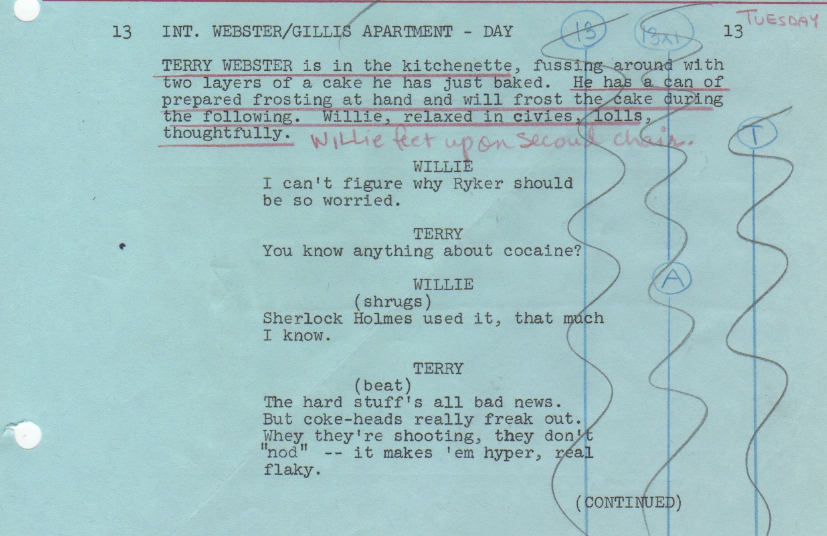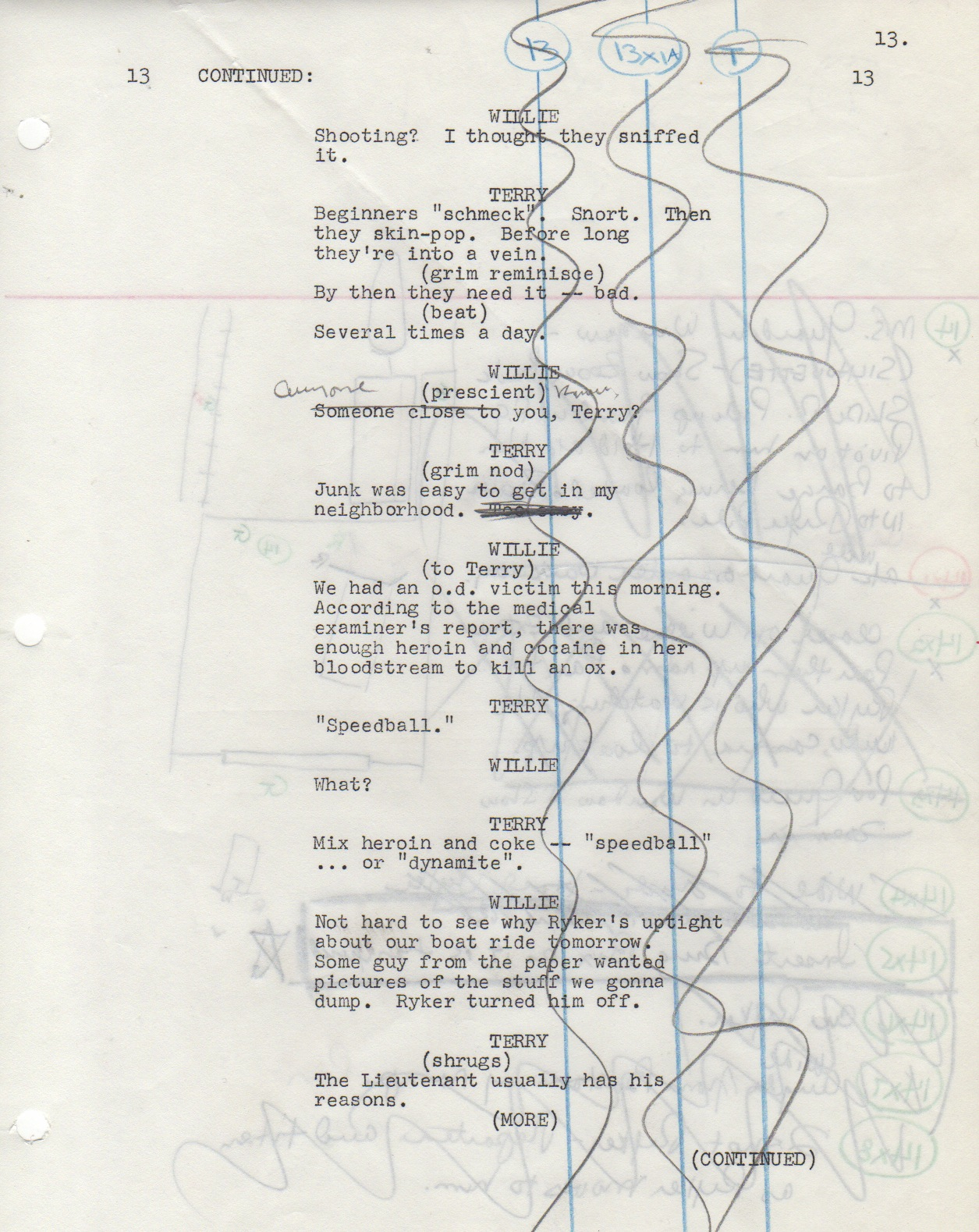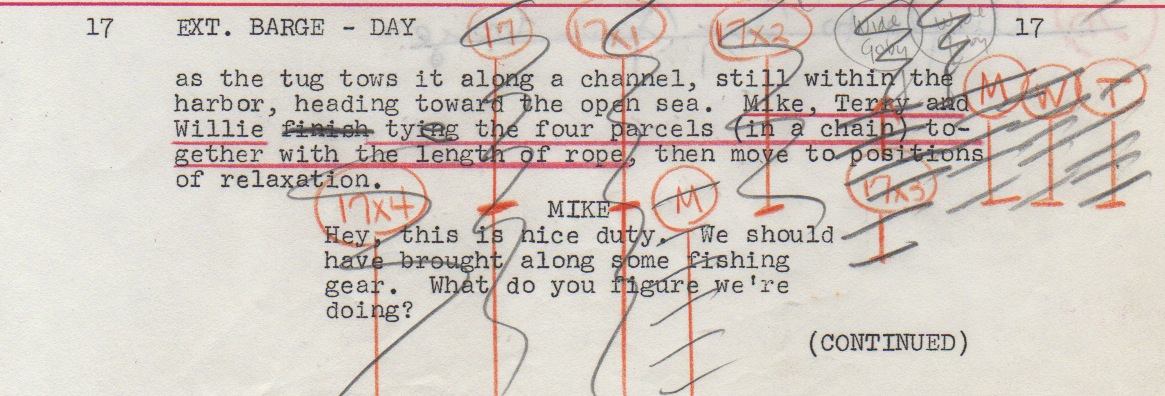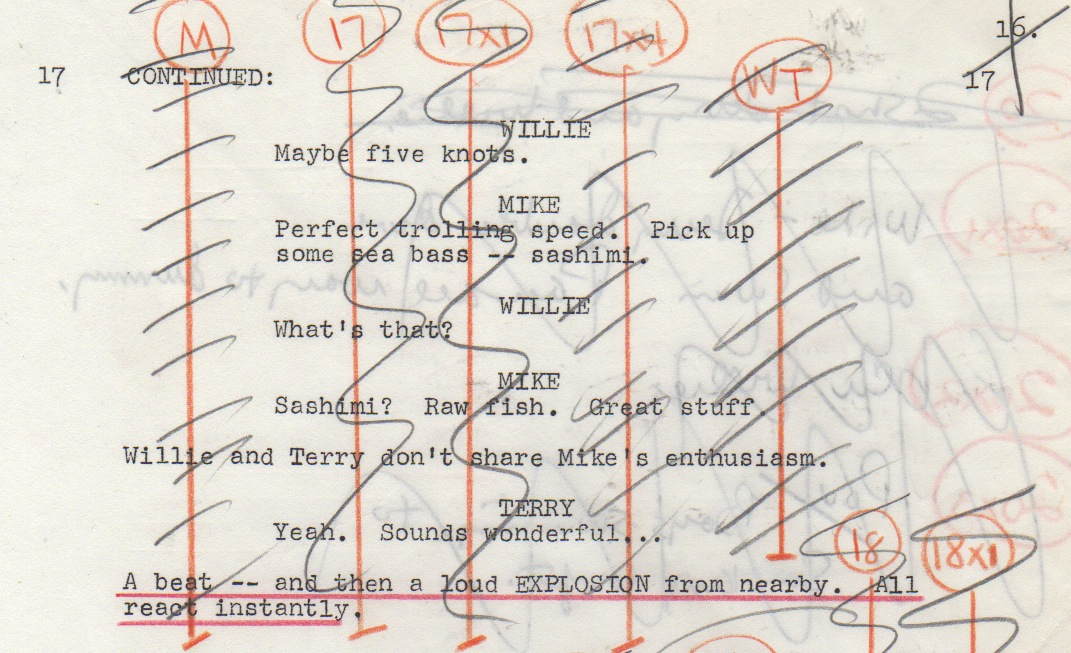FILMED October 1972
Venice, California is a beachfront neighborhood of the city of Los Angeles, situated south of Santa Monica. Founded in 1905 as a seaside resort town, several miles of canals were dug to drain the marshes in preparation for the residential areas soon to be developed. The community, originally called “Venice of America” (and I’m sure you can figure why it was called that) was an independent city until 1926, when it merged with Los Angeles, but with the exception of new police and fire stations in 1930, the city spent little on improvements after annexation. By the 1950s Venice had deteriorated and become known as the “Slum by the Sea.” By 1972, with its small weatherworn structures lining the canals and its impressively long boardwalk, Venice was a favorite site for filming by the Hollywood community. It was an ideal location for our current story.
The Old Woman at the scene of the crime was my dear friend, Adrienne Marden. I wrote in great detail about Adrienne in my post for THE CRADLE on THE WALTONS; I told of the incredible circumstances that led to her first film role forty years earlier in RASPUTIN AND THE EMPRESS starring the Barrymores, John, Lionel and Ethel. Her entry onto the Broadway stage was just as stunning. Two years after her film debut Adrienne auditioned for George S. Kaufman and Moss Hart’s MERRILY WE ROLL ALONG and was cast. The play, although a financial failure, was an esteemed success. She followed that auspicious debut playing the daughter of Fredric March and Florence Eldridge in THE AMERICAN WAY. Later she was one of THE WOMEN when Claire Boothe Luce’s play took Broadway by storm (her role was played in the MGM movie by Joan Fontaine.) The interesting thing was that Adrienne always felt that her actor friends discounted her as an actress because her early success had come so easily; she said they attributed it to her beauty rather than her talent. I think she was overly sensitive. In her 60s she was still a beautiful woman, a very accomplished actress and in her later years a brilliant theatre director.
The script was 64 pages. The first edited assemblage was certain to run at least 60 minutes if not longer, but the running time for an episode was only about 49:30. That was one of the perils of filming television – the length of a film was determined and limited by its time slot, not by the time it took to tell the story most effectively. Here’s a scene that was filmed and left on the cutting room floor. Too bad! It contained interesting and relevant information about cocaine!



THE SNOW JOB was the second and final episode of THE ROOKIES that I directed. As with the previous episode, we had a seven-day schedule. For our first day of filming we went to Wilmington Harbor in South Los Angeles.
But many times the elimination of scenes in editing was an improvement. Here is the scene of the three Rookies tying the parcels of cocaine together that preceded the explosion. The scene was cut out in editing because of time. I thought the sequence played better with its omission.


I didn’t give it a second thought at the time, but now I have a question. Wouldn’t it be polluting to dump cocaine into the ocean? Even more so if Ryker’s stated plan was carried out to empty the cocaine from its glassine containers before dumping!
When 20th Century Fox sold the property that was the studio’s backlot, the area that became Century City, it only had the Fox ranch in the far valley for their backlot sequences, and the ranch was devoid of urban structures. As I recall, the parking lot entrance to Memorial Hospital, the hospital where Jill worked, was created outside of Stage 18. There was a parking lot there, and the entrance to the soundstage became an entrance to the hospital.
Our second day of filming was in Venice, and we ended up shooting all over the area. There was the opening scene with the Old Woman and the 2 Rookies plus the interior of one of the small houses with the unconscious girl; the coffee stand and surrounding area; the Playland scene with the machine gun game and the exterior there; the exterior of the apartment building where Country lived and the telephone booth. That was the good part of filming in Venice. We were able to find all of those diverse and colorful settings reasonably close to each other, and went back to the studio at the end of the day having completed our 7 pages with 36 camera set-ups.
Rita Lakin, the creator of THE ROOKIES, was a pioneer of female Hollywood writers. What I thought separated her from the crowd was that she not only wrote for shows like DR. KILDARE, PEYTON PLACE, MEDICAL CENTER, FAMILY AFFAIR, and DYNASTY, she also wrote for action series. I didn’t meet Rita when I was directing THE ROOKIES. I met her four years later when she was an Executive Producer on MGM’s EXECUTIVE SUITE, and therein lies an unusual experience. EXECUTIVE SUITE was another attempt by a major studio (MGM) and a television network (CBS) to duplicate the success 20th Century Fox and ABC had in turning a major film success (PEYTON PLACE) into a successful nighttime soap opera. Midway through the season I was booked to direct two episodes. I reported to MGM, my original film studio out in Culver City, went through my six or seven days of preparation and then went before the cameras. As the third day of filming drew to a close, Executive Producer Rita Lakin and Producer Buck Houghton surprisingly arrived on the set. They announced to a startled cast and crew that they had just received word that CBS had pulled the plug. The series was being cancelled! I had directed for series before that were cancelled. That was the first time for me for a series to be cancelled midway through an episode I was directing.
And now we come to one of my eternal beefs. Martin shot Ron Soble at close range, but you could barely see the bloody spot on his shirt where the bullet hit. I think it was larger than a dime but smaller than a quarter. The networks insisted on action, the more violent the better, but it always had to be neat. You couldn’t do anything that might offend the viewers. As a result I felt the killings on screen didn’t seem real. Killing is ugly and bloody, and that’s the way it should look on film, but I have to go one step further. Today the violence on screen is at the other extreme. It is so over-the-top bloody, that it too is unreal – more comic book, so that it tends to evoke nervous laughter. There is a happy medium: present the ugly violence, but without disrupting the scene’s aesthetic distance.
This past week I viewed on cable THE TAMING OF THE SHREW with Elizabeth Taylor and Richard Burton. The show was hosted by Robert Osborne, and in his closing statement Osborne said, “…but what caught everybody off guard was how well Elizabeth Taylor did as Kate … and after 15 years experience on the sound stage, she certainly knew how to make a camera work for her.” I bring this up because I say that in his performance as Country, Martin Sheen knew how to make a camera work for him. I will take it a step further – he owned the camera.



Another great post (and episode) Ralph. I wasn’t a religious watcher of the “The Rookies” – I can’t remember but there was another program on at the same time that I preferred. But my main reason for tuning in was to watch Gerald O’Loughlin – what a great actor. Like many of that ones we’ve discussed before (Vic Morrow, Robert Lansing, David Janssen, Richard Thomas, etc.), he just resonated on-screen. Whatever role he was performing, he brought a “reality” to the part – the character just became “real”.
This episode was a real treat, Martin Sheen and Gerald O’Loughlin – two greats, plus one of my favorite actors from the 60/70s; Don Dubbins.
I’m so happy to hear your feelings about Don Dubbins. I always felt Don was one of the underrated actors who slipped through the cracks. We met first in 1960 when I directed him in THE GOLDEN FLEECING on the main stage of the Pasadena Playhouse. Don had starred with Deborah Kerr in the national company of TEA AND SYMPATHY. My favorite television show with him was IN THE CLOSING OF A TRUNK on ROUTE 66. He was a solid actor with great sensitivity.
Couldn’t agree more. Whether in a very subdued role or one where he could chew the scenery, Mr Dubbins always gave a great performance. In the 60/70s, it seemed like on any given week, he would be on three or four separate programs. You’d certainly know better than I but it seemed Quinn Martin and Jack Webb also admired his talents – I recall he tended to pop up in their shows very frequently.
Hello sir,
I just have been reading this article and I wanted to leave a comment to tell you how much I had appreciated this episode 🙂 I wasn’t really familiar with the Rookies series and (to tell the truth) mainly watched it for Martin Sheen that I had started to watch and to like in movies such as “Apocalypse Now” and “Badlands” and so on… I really got interested in his career and so I started to search for TV work he had done that I could find on the internet to watch. I just wanted to say that I really liked “Snow Job” a lot, I really like 70s cops shows in general but this ep was really well done, with the whole Vietnam War context. And I really, really loved Mr Sheen in it, it just rang so true at times it didn’t feel as if he was acting, he was really unforgettable ! Anyway, I found really interesting the insight you gave of the shooting and the videos and about the deleted scenes and so on… Actually, I think I’m gonna read other articles you posted, I really enjoyed this one 🙂 To be truly honest, I can’t really believe you’ll may be reading this comment – I mean considering you’re a famous director – and I hope you’ll forgive me if I sound a little bit too fandom right now ! I’m glad to read you enjoyed working with Mr Sheen, finally. And I sure would love to read more about it 🙂
Don’t be silly! I LOVE reading comments like the one you wrote. And I too was and am a big fan of Martin Sheen. I think THE SNOW JOB was the last time we worked together. The first time was in 1963 when he was a young New York actor newly arrived on the west coast. I had seen him in an episode of THE DEFENDERS and was terribly impressed and when the casting director suggested him for a show I was directing, I jumped at the chance. If you want to see more of his work, go to my posts of A SECOND LIFE (TH FBI), OLD KING COLE (INSIGHT) and DEAD WITNESS TO A KILLING (DAN AUGUST). You can read about him on my post for CHARLES (MATT LINCOLN) but I don’t have the film on that one.
Oh thanks for your nice (and quick) answer, that’s really kind 😀 Oh that’s real cool, yes I understand, even in his first (and not lead) parts, he was already so great ! I had the luck to find some parts from a Naked City episode he made in the early 60s and an extract from Arrest and Trial, I think, and it looked really nice ! Oh yes, I would really love to, I’ll just start to read them this afternoon I guess and no prob if there isn’t the movie, it’s still great to have all the trivia 🙂
Anyway thanks again, Mr Senensky, you really made my day ! 🙂 I know it’s a bit late but Merry Xmas all the same ! 😀
I can’t get enough of this site. I’m reading everything and loving it. I was a huge Rookies fan (I’m 50) and, my older brothers and sister watched it every week. It was a great show and acted so well by the cast. I had huge crush on Kate Jackson. I thought her and Sam Melville were great as Jill & Make Danko. Also, George Standford Brown & Michael Ontkean made great police partners. Although, I don’t think the show recovered when Ontkean left the show. Even though, I think Bruce Fairbairn did a fine job. What was the reason that Ontkean left? Money? Cast feuding? Didn’t want to be typecasted?
First off, I want to congratulate you on being addicted to my website. Then I wish I could answer your question about Ontkean’s leaving. I had no connection to the series after THE SNOW JOB. My guess would be he left to try his luck at feature films. He did do some. THE ROOKIES was one of Spelling’s better series.
I have a couple of questions. 1, Regarding the ‘unnamed city’ that they are representing where even Jill Danko’s drivers license address only gives the city of residence as S.C. City, California. Some report that it is for Santa Clara, can you advise?
2, There were several different exterior establishing shots in use for the hospital. I counted 5 different facilities in season one alone. The most recognizable was Glendale Memorial Hospital being the most often used throughout the series (also in Miami Vice and Mission Impossible). The first one we see is in 1.06 and it is called Northside Memorial’ (unknown actual facility) but after that it is simply Memorial Hospital. Any Idea why so many different file footage shots were used?
Thank you for taking the time.
Richard
Richard, I wish I could answer your questions, but I can’t; I can only guess. As to the name of the city, I would guess that they wanted an unnamed California city to avoid any possible problems later of having something occur in a story that reflected unfavorably on a named city. That could cause a wave of resentment from the city’s residents and possibly law suits from the city government. As for the establishing exterior shots of the hospital, that is all done in the editing room; those shots are pulled from stock. I wonder if the editors even knew the location of the shots they used.
Ralph, Thank you. Appreciate your thoughts and your work.
I just found your site and beginning to go through it. Regarding hospital establishing (above) I discovered that the Westside Medical hospital establishing was lifted and used in several CHiPs episodes.